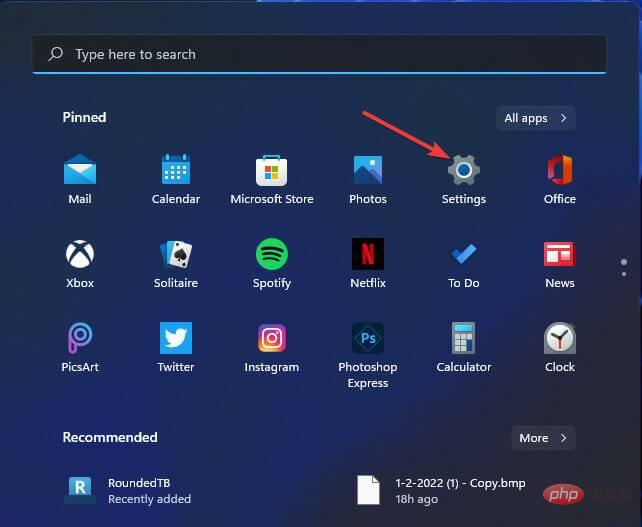The shortcomings of firewall technology are application layer attacks, internal attacks, advanced persistent threats, complex firewall rule management, firewall single points of failure, the firewall's inability to protect terminal devices, and the firewall's inability to prevent internal data leakage. Detailed introduction: 1. Application layer attacks. Traditional firewalls mainly work at the network layer and transport layer. They are relatively weak against application layer attacks. Malicious code in HTTP requests, SQL injection, cross-site scripting attacks, etc. are difficult to attack. Detected and blocked by traditional firewalls because firewalls don’t have deep visibility into application layer data, etc.

The operating system for this tutorial: Windows 10 system, DELL G3 computer.
Firewall technology is an important technology in computer network security. It protects computers and network resources from potential attacks by monitoring and controlling network traffic. However, firewall technology is not perfect and has some flaws and limitations. The shortcomings of firewall technology will be described in detail below.
Application layer attacks: Traditional firewalls mainly work at the network layer and transport layer, and are relatively weak against application layer attacks. For example, malicious code in HTTP requests, SQL injection, cross-site scripting attacks, etc. These attacks are difficult to detect and block by traditional firewalls because the firewall cannot deeply understand the data at the application layer.
Internal attacks: Firewalls are usually deployed at the edge of the network to protect the internal network from external threats. However, it does not protect against insider attacks, which are threats that come from within the network. This is because the firewall is not sensitive to traffic in the internal network, and internal attackers can carry out attacks by bypassing the firewall or exploiting the privileges of the internal network.
Advanced persistent threats (APT): Traditional firewalls are mainly based on signature matching and blacklisting to detect and block threats, while advanced persistent threats are usually hidden using advanced technologies and are difficult to detect through traditional firewalls and block. APT attackers can use encrypted communications, covert transmission channels and other means to bypass firewall monitoring and defense.
Firewall rule management is complex: Firewall rules are the key to configuring the firewall, controlling network traffic by defining allowed and prohibited traffic rules. However, as networks expand in size and complexity, firewall rule management becomes very complex and difficult. Problems such as rule conflicts, rule overlaps, and rule errors may cause firewall failure or security vulnerabilities.
Firewall single point of failure: The firewall is usually one of the key devices in the network, and its failure may cause the entire network to lose protection. If a firewall fails or is attacked, the network will not function properly and will be vulnerable to attack. Therefore, a single firewall risks a single point of failure.
Firewalls cannot protect terminal devices: Firewalls mainly protect the edge of the network and cannot provide effective protection for terminal devices, such as personal computers and smartphones. End devices may be attacked by malware, viruses, worms, etc. Firewalls cannot prevent these attacks.
Firewalls cannot prevent internal data leaks: Firewalls are mainly used to control the incoming and outgoing network traffic, but their protection against internal data leaks is relatively weak. If endpoint devices on the internal network are infected with malware or compromised, attackers can leak sensitive data to the outside by bypassing the firewall.
To sum up, although firewall technology plays an important role in network security, it still has some flaws and limitations. In order to improve the level of network security, we need to comprehensively apply a variety of security technologies, such as intrusion detection systems, vulnerability scanning, etc., to build a more robust and comprehensive network security defense system.
The above is the detailed content of What are the flaws of firewall technology?. For more information, please follow other related articles on the PHP Chinese website!
 修复:Windows 11 上的 Windows 激活错误 0x87e10bc6Apr 19, 2023 pm 01:37 PM
修复:Windows 11 上的 Windows 激活错误 0x87e10bc6Apr 19, 2023 pm 01:37 PM当某些用户尝试通过设置使用产品密钥激活平台时,会出现Windows11激活错误0x87e10bc6问题。发生该问题时,“设置”中的“激活”选项卡会显示以下错误消息:某些东西阻止了我们与激活服务器进行通信。等待几分钟,然后重试。错误代码:0x87e10bc6。由于防火墙阻止了与Microsoft的激活服务器的连接,因此可能会出现特定的激活错误。因此,当出现该错误时,用户无法使用其产品密钥激活Windows11。不幸的是,即使是Windows10用户过去也受到同样问题的困扰,因此准备好处
 如何修复OneDrive中的“错误:0x80070185,云操作不成功”May 16, 2023 pm 04:26 PM
如何修复OneDrive中的“错误:0x80070185,云操作不成功”May 16, 2023 pm 04:26 PMOneDrive是微软提供的流行的云存储应用程序。我们大多数人使用OneDrive来存储我们的文件,文件夹,文档等。但是一些用户抱怨说,当他们尝试访问OneDrive上的共享文件时,它会给出错误,指出“错误:0x80070185,云操作不成功”。因此,他们无法在OneDrive上执行任何操作,例如复制文件,粘贴,下载共享文件等。如今,有必要在我们的日常工作中使用这些操作。此错误可以轻松解决,为此,我们有一些方法可以应用并尝试解决问题。让我们开始吧!方法1–注销并重新登录到OneDrive应用步骤
 如何在 Windows 11 中阻止对应用程序的 Internet 访问Apr 14, 2023 pm 06:46 PM
如何在 Windows 11 中阻止对应用程序的 Internet 访问Apr 14, 2023 pm 06:46 PM如何在Windows11中阻止对应用程序的Internet访问要使用WindowsDefender防火墙阻止应用在Windows11中访问Internet,请执行以下操作:单击开始按钮或按键盘上的Windows键,然后键入windowsdefenderfirewall并单击开始菜单中的顶部结果。当WindowsDefender防火墙窗口打开时,单击左侧的高级设置。从左侧面板中选择OutboundRules,然后在右侧单击Actions下的NewRule。在新的出站规则
 如果 Grammarly 无法在 Windows 10 浏览器上运行的 8 个重大修复May 05, 2023 pm 02:16 PM
如果 Grammarly 无法在 Windows 10 浏览器上运行的 8 个重大修复May 05, 2023 pm 02:16 PM如果您在Windows10或11PC上遇到语法问题,本文将帮助您解决此问题。Grammarly是最流行的打字助手之一,用于修复语法、拼写、清晰度等。它已经成为写作专业人士必不可少的一部分。但是,如果它不能正常工作,它可能是一个非常令人沮丧的体验。许多Windows用户报告说此工具在他们的计算机上运行不佳。我们做了深入的分析,找到了这个问题的原因和解决方案。为什么Grammarly无法在我的PC上运行?由于几个常见原因,PC上的Grammarly可能无法正常工作。它包括以下内
 如何修复 Valorant 的 Vanguard Windows 11 错误Apr 15, 2023 pm 08:55 PM
如何修复 Valorant 的 Vanguard Windows 11 错误Apr 15, 2023 pm 08:55 PM当玩家尝试在Windows11中启动Valorant时会出现这两个Vanguard错误。因此,由于这些错误,玩家无法玩Valorant。如果您需要解决其中一个问题,请查看下面的潜在修复程序。什么是Vanguard?Vanguard是Valorant游戏的反作弊软件。Riot软件随游戏一起安装,以防止玩家在Valorant中作弊。如果没有安装并激活RiotVanguard软件,您将无法玩Valorant。该软件有些争议,因为它会阻止应用程序。玩家抱怨Vanguard即
![修复:Steam 无法同步您的文件错误 [已解决]](https://img.php.cn/upload/article/000/465/014/168136171341011.png) 修复:Steam 无法同步您的文件错误 [已解决]Apr 13, 2023 pm 12:55 PM
修复:Steam 无法同步您的文件错误 [已解决]Apr 13, 2023 pm 12:55 PMSteam 是一个深受全球游戏玩家欢迎的游戏分发平台。它包含大量游戏,Steam 玩家可以从 Steam 商店购买并通过 Steam 客户端在线玩这些游戏。但是,与任何其他应用程序一样,Steam 自身也面临一些网络连接问题,因此无法通过 Steam 云同步文件。在这里,正在讨论许多用户在尝试通过 Steam 云打开游戏时遇到的错误。用户面临一条错误消息,显示为Steam 无法为特定游戏同步您的文件并且游戏无法自行启动。此错误的可能原因如下。Steam 服务器已关闭且无法访问。损坏的游戏文件St
 如何在 Windows PC 上修复 Steam 错误代码 130Apr 28, 2023 pm 01:40 PM
如何在 Windows PC 上修复 Steam 错误代码 130Apr 28, 2023 pm 01:40 PMSteam是一个流行的在线游戏流媒体平台,允许其用户购买和玩游戏以及与平台上的其他游戏玩家聊天。除了它提供的功能外,平台上还会遇到一些错误。许多Steam用户遇到的此类错误之一是“错误代码:130无法加载网页(未知错误)”。当Steam客户端尝试加载网页但无法从其服务器检索该页面时,会出现此错误。此错误代码可能会显示在Steam客户端的任何页面上,包括库存页面、更新新闻或阻止您搜索您有兴趣购买的游戏的商店页面。此问题的主要原因之一是您的PC上的互联网连接较弱。其他可能的原因是Stea
 如何修复现代战争错误原因10,错误代码2004Apr 13, 2023 pm 03:22 PM
如何修复现代战争错误原因10,错误代码2004Apr 13, 2023 pm 03:22 PM没有在线多人游戏体验,现代战争什么都不是。但是,在现代战争 2 中进行匹配时,您可能偶然发现了一个名为“错误原因 10”的问题。错误代码 2004”。这是仅在在线匹配时发生的错误。但是,有一些解决方案可以解决这个问题,您可以立即进入多人游戏。解决方法 –1.只需关闭游戏并重新启动即可。重新启动游戏应该可以解决问题。2. 检查您的设备连接的网络连接。多人游戏需要稳定、低延迟的网络速度才能正常工作。修复1 –删除MW2保存的文件损坏的现代战争 2 保存的文件导致了此问题,您可以通过从系统中删除 MW

Hot AI Tools

Undresser.AI Undress
AI-powered app for creating realistic nude photos

AI Clothes Remover
Online AI tool for removing clothes from photos.

Undress AI Tool
Undress images for free

Clothoff.io
AI clothes remover

AI Hentai Generator
Generate AI Hentai for free.

Hot Article

Hot Tools

SAP NetWeaver Server Adapter for Eclipse
Integrate Eclipse with SAP NetWeaver application server.

EditPlus Chinese cracked version
Small size, syntax highlighting, does not support code prompt function

Dreamweaver Mac version
Visual web development tools

Notepad++7.3.1
Easy-to-use and free code editor

VSCode Windows 64-bit Download
A free and powerful IDE editor launched by Microsoft






